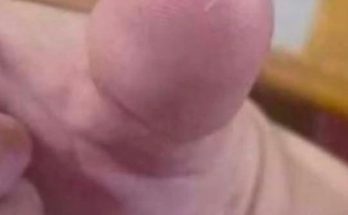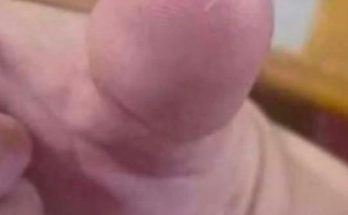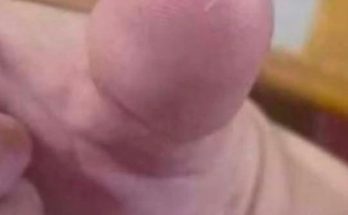For most people, tattoos are simply a form of art — a way to express themselves, to capture memories, or to celebrate their individuality. For others, they hold cultural or spiritual meaning, symbolizing beliefs, struggles, or identity. But in many places, body modification remains controversial, sometimes even viewed as taboo. Few people challenge those limits more openly than Toxii Daniëlle — a woman who has taken self-expression far beyond conventional boundaries.

Toxii isn’t just heavily tattooed — she’s one of the most modified individuals in the world. Her body is a canvas of transformation. Almost every inch of her upper body is covered in solid black ink. Her tongue is split down the middle like a serpent’s. Beneath her skin are small silicone implants that form subtle ridges, reshaping the contours of her body. And most shocking of all — she had her nose surgically removed.
Yes, removed.
She keeps it preserved in a small jar, along with other body parts altered through her journey. It’s not a stunt, not an accident — but a deliberate act of self-definition.
With over 155,000 followers on Instagram, Toxii has built a devoted audience fascinated by her metamorphosis. She shares her modifications with unflinching honesty — no filters, no apologies. Her photos draw both admiration and outrage, praise and disgust. For some, she’s an icon of artistic freedom. For others, a cautionary tale about self-destruction.
The debate about her choices reignited recently after she appeared in an interview with street artist Devon Rodriguez, who asked her the question everyone was thinking: Why?
Toxii’s answer was simple and startlingly sincere. “Because I like to be imperfect,” she said. “I think imperfections make you unique.”
For her, body modification isn’t about chasing beauty — it’s about rejecting the very idea that beauty should have limits. It’s about reshaping herself into something that feels authentically her, even if that version shocks everyone else.
In the interview, she admitted that the nose removal was the most painful procedure she’d undergone — even more than the horn-like implants she has on her forehead. Rodriguez asked her, half in disbelief, “Did you keep the nose?”
She nodded without hesitation. “I have all my body parts, in little jars, yeah.”
The statement went viral. The image of a woman keeping parts of her own body preserved in jars fascinated and disturbed people in equal measure. But to Toxii, it’s not macabre — it’s symbolic. She sees it as honoring the stages of her evolution, as if each modification represents shedding a former self while still acknowledging its existence.
A few weeks later, she stunned her followers by posting a throwback photo of herself before the tattoos, before the implants, before the nose removal. The contrast was breathtaking. The photo showed a fresh-faced young woman with long blond hair and soft features — almost unrecognizable compared to the dark, alien-like figure she presents today.
The reactions were explosive. Thousands of comments poured in within hours.
“You were so beautiful before,” one person wrote. “What on earth made you do this to yourself?”
Another said, “You must hate yourself to destroy your body like that.”
Some called her brave, others called her insane. A few linked her transformation to satanic rituals, convinced that no one in their right mind would willingly disfigure themselves like this.
Yet, amid the harsh criticism, there were voices of admiration. Fans and fellow tattoo enthusiasts defended her fiercely. “Beautiful before, during, and after,” one follower wrote. “Real art doesn’t need to make sense to everyone.”
Another said, “She’s living her truth. That takes more courage than most of us will ever have.”
The comments section became a battleground between two worldviews — those who believe beauty has objective limits, and those who see it as a spectrum defined by personal choice.
Toxii herself didn’t lash out at her critics. Instead, she replied with a calm statement that revealed her mindset more clearly than anything else: “I’m not trying to be beautiful for anyone else. I’m trying to be free.”
For her, the physical transformation is deeply connected to her sense of identity. She’s said in past interviews that she struggled for years with how she looked — not because she hated herself, but because she felt invisible, like her outward appearance didn’t reflect the way she saw herself inside. Tattoos and body modifications became her language, a way of translating her inner world into something tangible.
But there’s another layer to her story that most people miss — the psychological endurance behind it. The pain involved in extreme body modification is intense. Removing parts of the body, altering facial structure, and implanting foreign materials beneath the skin all carry serious medical risks. Yet Toxii insists that each procedure brought her closer to peace.
“It’s not about pain,” she explained once. “It’s about transformation. The body heals, but the mind changes with it.”
Her journey challenges our collective comfort zones. Society loves the idea of individuality — but only within acceptable limits. We celebrate self-expression when it’s elegant, fashionable, or inspiring. But when it confronts our idea of normality, it suddenly becomes “wrong.” Toxii’s existence forces people to look at that contradiction.
Still, even those who support her choices often express concern. Some psychologists who study extreme body modification warn that the line between self-expression and self-harm can blur easily. They emphasize that modifications should be spaced out over time, allowing the body and mind to adjust — something even some of Toxii’s fans have echoed.
One comment under her latest post read, “I think these decisions are best made slowly. Quick impulsiveness breeds regret.”
Maybe they’re right. Or maybe Toxii understands something the rest of us don’t — that regret isn’t always tied to change, but to the fear of never changing at all.
When you scroll through her feed, it’s clear that despite the controversy, she radiates a kind of strange confidence. There’s power in her posture, defiance in her gaze. Whether she’s posing under soft light or standing in a dark alley with her inked skin glowing like armor, she owns every inch of who she’s become.
The irony is that people call her “inhuman,” yet her story is deeply, painfully human. She’s just externalized the struggle most of us hide — the need to shape ourselves into something that finally feels true.
Toxii once captioned a photo with a line that sums up her philosophy perfectly: “I’m not chasing beauty. I’m becoming art.”
You can disagree with her. You can even recoil from the sight of her transformation. But what’s undeniable is her commitment — the raw courage it takes to rebuild your body, your image, and your life on your own terms, knowing the world will judge you for it.
Four years transformed her from an ordinary young woman into a living embodiment of her own vision. And whether you call that madness or mastery, it’s a reminder of how powerful — and polarizing — human freedom can be.
In a world obsessed with perfection, Toxii Daniëlle has chosen to be deliberately imperfect. And maybe that’s the most radical act of beauty there is.


